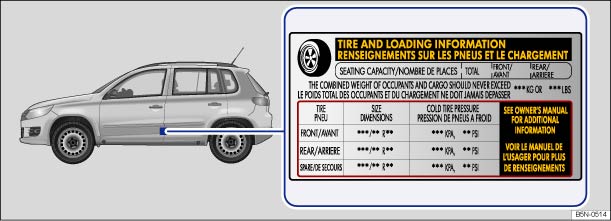Volkswagen Tiguan Owners Manual: Tire inflation pressure

Fig. 171 Location of the tire inflation pressure label.
 Read and follow the introductory information and
safety information first⇒
Read and follow the introductory information and
safety information first⇒ Introduction
to the subject
Introduction
to the subject The correct tire inflation pressure for the factory-installed tires is listed on a label. The factory-installed tires may be summer, winter, or all-season tires. The label ⇒ Fig. 171 is on the driver door jamb.
Under- or over-inflation significantly shortens the service life of your tires
and affects the handling of the vehicle ⇒ .
The correct tire pressure is very important, particularly when the vehicle is driven
at higher speeds. Incorrect tire pressure causes increased wear
and even sudden tire failure and blowouts.
.
The correct tire pressure is very important, particularly when the vehicle is driven
at higher speeds. Incorrect tire pressure causes increased wear
and even sudden tire failure and blowouts.
Therefore, tire pressure should be checked at least once a month and always before long trips.
The specified tire inflation pressure applies to a cold tires. When tires are warm, the pressure will be higher than when the tires are cold.
Do not reduce the tire pressure on warm tires to match the required cold tire inflation pressure. The tire inflation pressure would then be too low and could cause sudden tire failure and blowout.
Checking tire inflation pressure
Always check the tire pressure only on cold tires when the vehicle has not been driven more than a couple of miles (kilometers) at low speed within the last 3 hours.
- Check tire inflation pressure regularly and on cold tires. Check all the tires, including the compact spare, if any. In colder climates tire pressure should be checked more often, but only when the tires are cold. Always use an accurate tire pressure gauge.
- After adjusting the tire inflation pressures, make sure to screw the valve caps back on; replace missing valve caps immediately. Please read and heed the information on resetting the Tire Pressure Monitoring System, if necessary ⇒ Tire pressure monitoring system (TPMS) .
- Remember that the vehicle manufacturer, not the tire manufacturer, determines the correct tire pressure for the tires on your vehicle. Never exceed the maximum inflation pressure listed on the tire sidewall for any reason.
Inflate the spare wheel to the pressure specified for the vehicle's road wheels on the tire pressure label; inflate a compact spare wheel to the pressure specified for the compact spare on the tire pressure label or on a separate label for the compact spare, if there is one.

 Warning
Warning
- Always inflate tires to the recommended and correct cold tire pressure before driving off.
- Low tire pressure can cause tires to get too hot, resulting in tread separation, sudden loss of pressure, and blowouts. Tires with excessively low pressure flex (bend) more, which can cause the tire to overheat and fail suddenly without warning.
- Excessive speed and/or overloading can cause heat buildup, sudden tire failure including a blowout and sudden deflation and loss of control.
- If the tire pressure is too low or too high, the tires will wear prematurely and the vehicle will not handle well.
- Regularly check tire inflation pressure, at least once a month, and also especially before a long trip.
- Check the pressure in all four tires when the tires are still cold. Never reduce air pressure in warm tires to match cold tire inflation pressure.

 Note
Note
- Make sure not to jam the tire pressure gauge into the valve stem. Otherwise you can damage the tire valves.
- Driving without valve caps, with the wrong valve caps, or with valve caps that are not properly screwed on can damage the tire valves and the sensors on the Tire Pressure Monitoring System. To help prevent damage, always use valve stem caps like those originally installed at the factory. The caps must be screwed on tightly. Do not use metal valve caps or comfort valve stem caps.

Underinflation increases fuel consumption.

Pressures measured with a gauge when inflating the tires may be different from the pressures read by the tire pressure sensors. The electronic TPMS is more accurate.

When the TPMS warns that the pressure in at least one tire is too low, check the tire pressure in all 4 tires with an accurate tire pressure gauge. Low tire pressure usually cannot be spotted by looking at the tire. This is especially true for low-profile tires. When checking the tire pressures, refer to ⇒ Tire pressure monitoring system (TPMS) .
 New and replacement tires
New and replacement tires
Read and follow the introductory information and
safety information first⇒Introduction
to the subject New tires
Drive a vehicle with new tires especially carefully for the first 350 miles ...
 Tire inflation pressure in cold tires
Tire inflation pressure in cold tires
Read and follow the introductory information and
safety information first⇒Introduction
to the subject
Drive train
Tire dimensions
Tire pressures
p ...
See More:
Volkswagen Tiguan Owners Manual > Jump-starting: Checklist
Switch off the ignition in both vehicles.
If necessary, open the battery cover in
the engine compartment Vehicle battery.
Attach one end of the red jumper cable
to the positive terminal ⊕ of the dead battery: Battery ① .
Attach the other end of the red jumper
cable to ...
Volkswagen Tiguan Owners Manual
Volkswagen Tiguan Service and Repair Manual
- Body exterior
- Body Interior
- General Paint Information
- Paint
- Brake System
- Suspension, Wheels, Steering
- Wheel and Tire Guide
- Towing Guide
- Wheel and Tire Guide General Information
- Communication
- Electrical Equipment General Information
- Electrical Equipment from 06/2011
- Heating, Ventilation and Air Conditioning
- Refrigerant R134a Servicing
- 6-Speed Manual Transmission 02Q, OBB, and OFB
